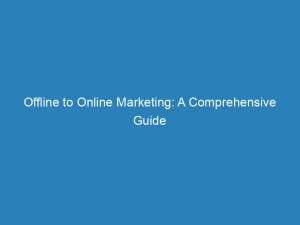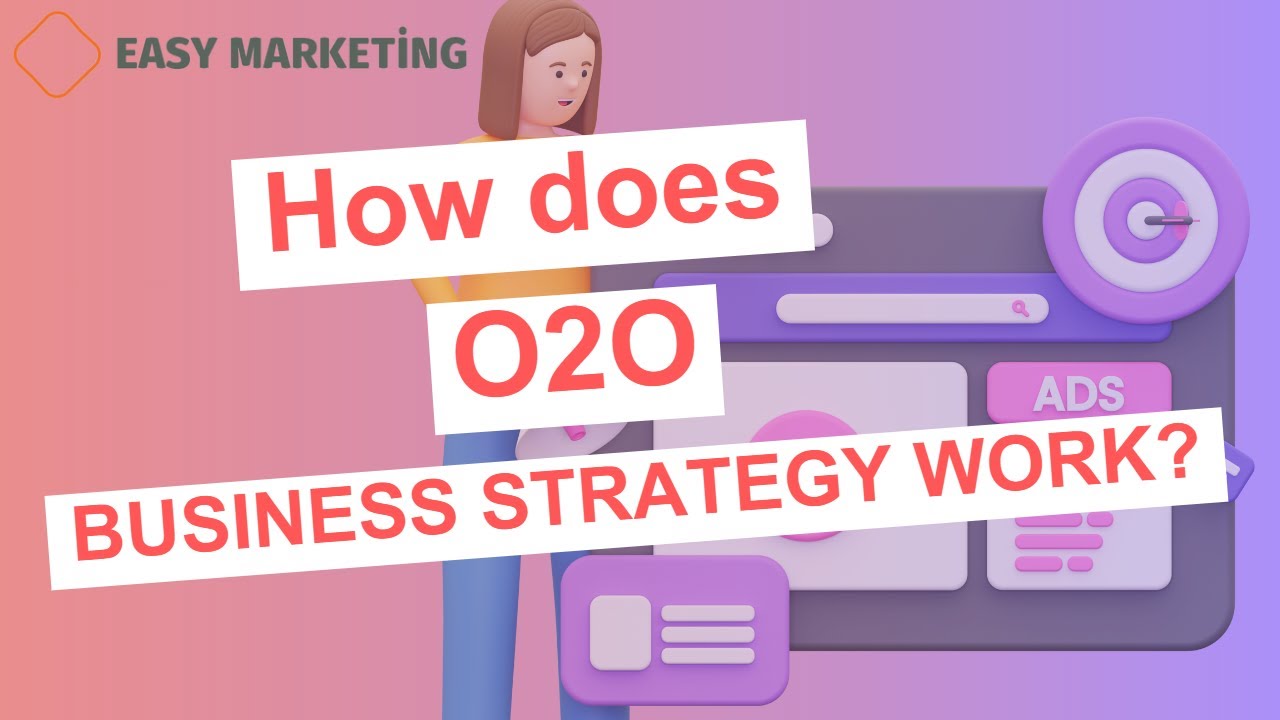In the ever-evolving world of marketing, the shift from offline to online strategies has become more crucial than ever. As the COVID-19 pandemic continues to reshape our lives, businesses must find innovative ways to bridge the gap between physical and digital experiences.
Enter offline-to-onlinemarketing, a game-changer that seamlessly guides customers from brick-and-mortar stores to their screens. From captivating virtual events to exclusive online memberships, these strategies revolutionize the customer journey, drive sales, and expand reach to a wider audience.
Join us as we dive into the exciting world where technology meets marketing, unraveling the endless possibilities of offline-to-online marketing.
Table of Contents
- offline to online marketing
- Offline-To-Online Marketing Drives Customer Traffic
- User Journey And Brand Identity Alignment
- Integration Of Offline And Online Strategies
- Transitioning Customers Through Virtual Events And Experiences
- At-Home Kits For Brand Experiences
- Real-Time Connection With Followers Through Live Streaming
- Engaging With User-Generated Content Through Branded Hashtags
- Creating Exclusive Online Memberships For VIP Customers
offline to online marketing
Offline to online marketing refers to the strategy of driving customers from physical stores to digital platforms. This approach focuses on creating a seamless user journey and aligning brand identity across offline and online channels.
Integration of offline and online marketing strategies is essential to engage customers and drive sales. Tactics such as virtual events, at-home experiences, going live, branded hashtags, and exclusive online memberships are key for transitioning customers from offline to online.
Virtual events have become particularly popular during the COVID-19 pandemic, providing a means to connect with customers remotely. At-home kits offer brand experiences that can be enjoyed from the comfort of one’s own home.
Going live on platforms like Instagram and TikTok enables real-time connection with followers, fostering engagement and loyalty. Creating a branded hashtag encourages user-generated content and boosts customer engagement.
Exclusive online memberships make customers feel like VIPs while providing recurring revenue. Adapting to new platforms and technologies is crucial for reaching a wider customer base.
Ultimately, combining both online and offline marketing strategies is essential for brand awareness and meeting the evolving needs of customers.
Key Points:
- Offline to online marketing drives customers from physical stores to digital platforms
- Integration of offline and online marketing strategies engages customers and drives sales
- Virtual events and at-home experiences connect with customers remotely
- Going live on platforms like Instagram and TikTok fosters engagement and loyalty
- Branded hashtags encourage user-generated content and boost engagement
- Exclusive online memberships make customers feel valued while generating recurring revenue
Sources
https://later.com/blog/offline-to-online-marketing/
https://www.forbes.com/sites/theyec/2021/02/08/nine-smart-ways-to-unify-online-and-offline-marketing-strategies/
https://blog.hubspot.com/marketing/offline-marketing
https://www.shopify.com/enterprise/o2o-online-to-offline-commerce
Check this out:
💡 Pro Tips:
1. Implement geotargeted online advertising to reach customers in specific physical locations.
2. Use personalized QR codes in physical stores to guide customers to online platforms for more information or discounts.
3. Offer incentives for customers to sign up for online newsletters or follow social media accounts, such as exclusive discounts or access to limited products.
4. Utilize retargeting ads to remind customers of products they may have seen in a physical store and encourage them to make an online purchase.
5. Collaborate with local influencers or partner with nearby businesses to cross-promote and expand your online reach within your target market.
Offline-To-Online Marketing Drives Customer Traffic
In today’s digital age, offline-to-online marketing plays a crucial role in driving customers from physical stores to digital platforms. This strategy allows businesses to tap into the vast potential of online marketing, ensuring a seamless user journey and aligning brand identity effectively.
Offline-to-online marketing encompasses various tactics that engage customers and ultimately drive sales. By integrating offline and online marketing strategies, businesses can effectively reach their target audience and cater to their needs.
User Journey And Brand Identity Alignment
When transitioning customers from offline to online, ensuring a seamless user journey and alignment of brand identity is of utmost importance. Customers should have a consistent experience across different touchpoints, whether it’s through physical stores or digital platforms.
To achieve a seamless user journey, businesses should focus on creating a cohesive brand presence across all channels. This includes consistent design elements, messaging, and tone of voice.
By reinforcing brand identity, customers will feel a connection and familiarity, regardless of whether they interact with the brand offline or online.
Integration Of Offline And Online Strategies
Integration is key when it comes to offline and online marketing strategies. By combining these two approaches, businesses can maximize their impact and engage customers on multiple levels.
This integration can take various forms, such as using offline promotions to drive online sales, or leveraging online marketing to boost foot traffic to physical stores.
Additionally, offline and online marketing strategies can complement each other in terms of measurement and analytics. By tracking and analyzing data from both channels, businesses can gain a deeper understanding of customer behavior and preferences.
This insight can then inform future marketing efforts and drive targeted campaigns.
Transitioning Customers Through Virtual Events And Experiences
Virtual events have gained significant popularity, especially during the COVID-19 pandemic, as they offer a safe and convenient way for businesses to connect with their customers. These events provide an opportunity to transition customers from offline to online, as they can participate from the comfort of their homes.
By hosting virtual events, businesses can showcase their products or services, provide interactive experiences, and engage with customers in real-time. Whether it’s a webinar, virtual conference, or live Q&A session, these events create a sense of exclusivity and build a loyal customer base.
At-Home Kits For Brand Experiences
Another effective tactic for transitioning customers from offline to online is the provision of at-home kits. These kits provide customers with branded experiences that they can enjoy in the comfort of their own homes.
For example, a beauty brand may offer an at-home spa kit, complete with their products and instructions for a relaxing self-care session.
By offering at-home kits, businesses can continue to engage with customers even when they are unable to visit physical stores. These kits create a unique brand experience and strengthen the connection between the customer and the brand.
Real-Time Connection With Followers Through Live Streaming
Live streaming on platforms like Instagram and TikTok has revolutionized the way businesses connect with their followers. Going live allows for real-time interaction and creates a sense of authenticity that resonates with customers.
Whether it’s showcasing behind-the-scenes footage, conducting product demonstrations, or hosting live Q&A sessions, businesses can engage their audience and build a loyal following.
Live streaming builds a stronger sense of community and allows customers to have a direct connection with the brand. This real-time interaction fosters trust and can ultimately drive sales as customers feel more connected and involved.
Creating a branded hashtag is an effective way to encourage user-generated content and increase engagement. By using a specific hashtag, businesses can motivate their customers to share their experiences, opinions, and photos related to the brand.
This user-generated content not only promotes the brand but also creates a sense of community among customers.
Engaging with user-generated content through branded hashtags allows businesses to leverage the creativity and influence of their customers. It also provides a valuable source of authentic and relatable content that can be used in future marketing campaigns.
Creating Exclusive Online Memberships For VIP Customers
Exclusive online memberships are a great way to make customers feel like VIPs and provide a recurring revenue stream for businesses. By offering exclusive benefits, discounts, early access to new products, or personalized experiences, businesses can incentivize customers to join their online membership program.
These exclusive memberships create a sense of exclusivity and make customers feel like they are part of a privileged group. It enhances customer loyalty and encourages repeat purchases, ultimately driving sales and revenue for the business.
In conclusion, offline-to-online marketing is a powerful strategy that drives customers from physical stores to digital platforms. By focusing on a seamless user journey and aligning brand identity, integrating offline and online strategies, transitioning customers through virtual events and experiences, providing at-home kits, engaging with user-generated content, and creating exclusive online memberships, businesses can effectively reach their target audience, boost brand awareness, and drive sales.
Adapting to new platforms and technologies is crucial for reaching a wider customer range and staying ahead in the ever-evolving digital landscape.












